This Italian bruschetta with mozzarella is the traditional way Italians eat bruschetta. No Italian barbecue is complete without bruschetta, slices of sourdough bread toasted on the barbecue, or simply grilled in the oven. The toasted bread is rubbed with garlic and drizzled with extra virgin olive oil. For the Summer, we like to top it with a Caprese: mozzarella, tomato, basil, and absolutely NO balsamic vinegar.
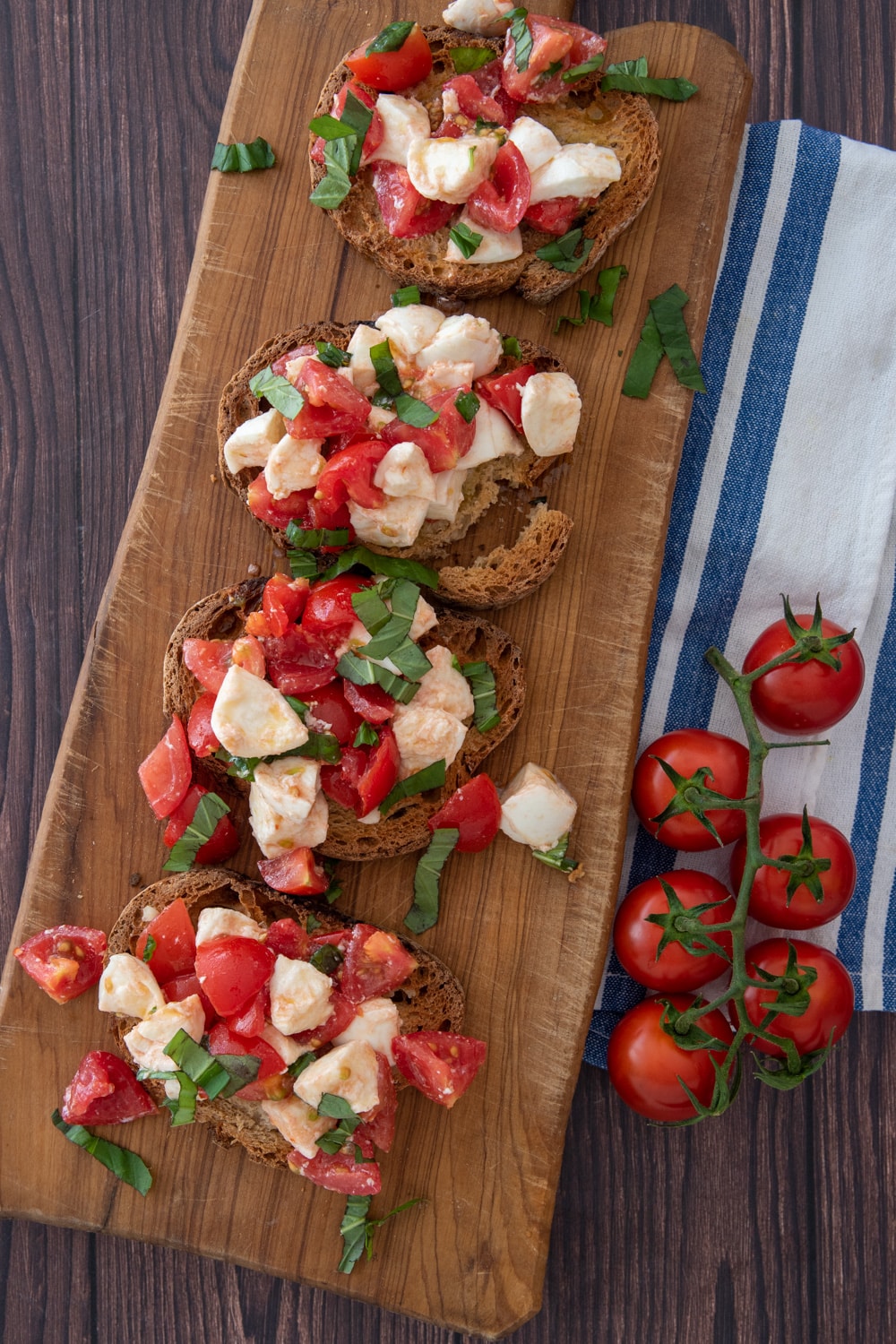
Jump to:
Bruschetta is one of these Italian recipes repeatedly ruined over the internet regarding ingredients and pronunciation.
Italian bruschetta is simple, easy to make, and made only with a few Mediterranean ingredients: garlic, extra virgin olive oil, fresh tomato, basil, and mozzarella.
That makes it an easy, fresh, and healthy start to a meal with family and friends.
Some ingredients do not belong to an Italian bruschetta:
- Bruschetta in Italy is never made with a baguette (we will see why later) and never with butter. This, to me, sounds more like garlic bread, which is not even Italian.
- If you are serving bruschetta topped with a Caprese salad, there is never any Balsamic vinegar.
For more Fake Italian Recipes on the web check out my Web Story: This Is Why You Should NEVER trust Italian recipes online
For more Italian traditional sandwiches, you can look up the recipes: Piadina, Provola and Nduja, Ferragosto picnic.
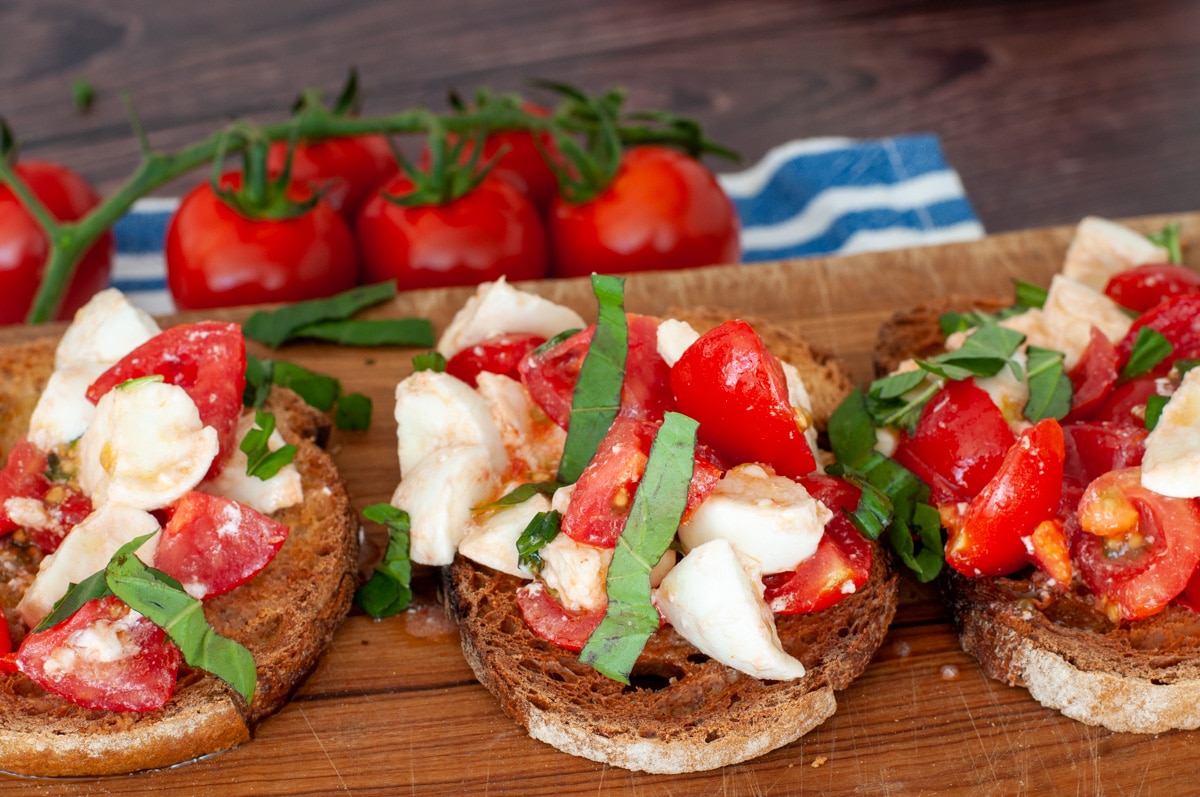
How do Italians say bruschetta?
I cringe when I hear Celebrity Chef pronouncing Bruschetta: BRUSHETTA!
HELLOOOOO!
Do your homework before you go on air, honey!
It is pronounced BRUSKETTA,
and I can understand if a man (or woman) from the street pronounces it wrong, but celebrity chefs broadcasting to millions of people should get their pronunciations right .... or just say Toast and make whatever you want!
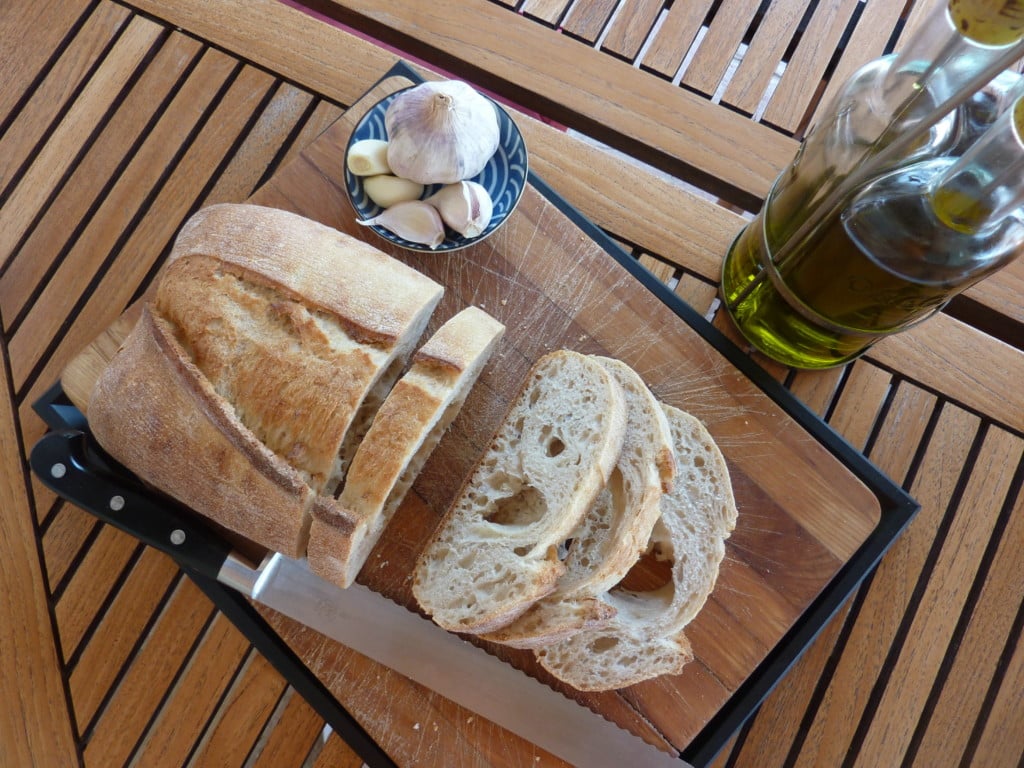
Ingredients
If you want to make a proper Italian Bruschetta (with the K), these are the ingredients you need:
- The bread: The bread to use for bruschetta must be sourdough bread. The inside should be soft with a chewy texture, while the outside crust should be crisp and crackly.
- Extra virgin olive oil: it is very important to have good quality extra virgin olive oil. You will find more information about it after the recipe cards.
- Garlic clove: every bruschetta should be served with garlic grated over the crispy bread. You can omit it if your guests have garlic intolerance.
- Fresh tomatoes: use good fresh tomatoes used for salad. You can use Cherry tomatoes, Pachino, or Bull heart. You do not need to remove the seeds. The tomatoes must release their juices so the bread can absorb them.
- Mozzarella: use fresh mozzarella, the one stored in water. You can use it for di latte, Buffalo, or burrata. Do not use the mozzarella used for cooking or pizza.
- Basil: fresh basil leaves to give color and taste
- Salt: for the tomato mozzarella salad
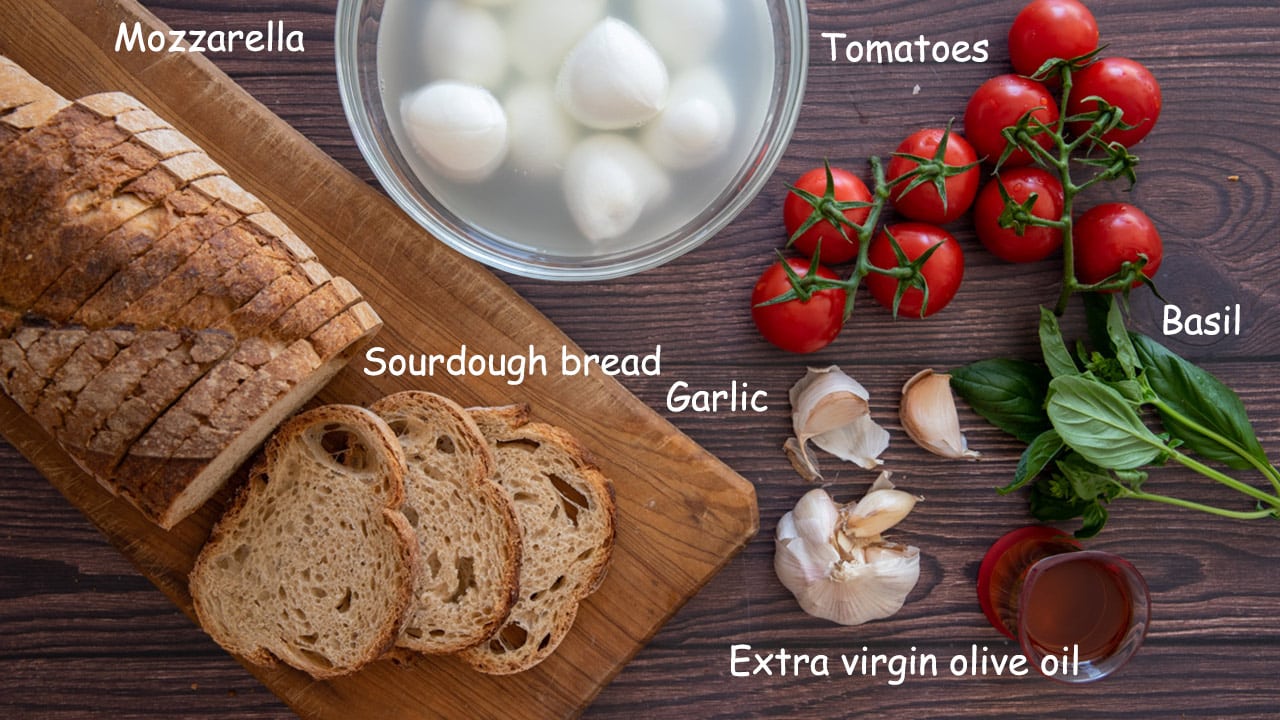
Hint: Because Bruschetta is a very simple recipe, the quality of the ingredients is very important. You should strictly use good sourdough bread and excellent extra virgin olive oil.
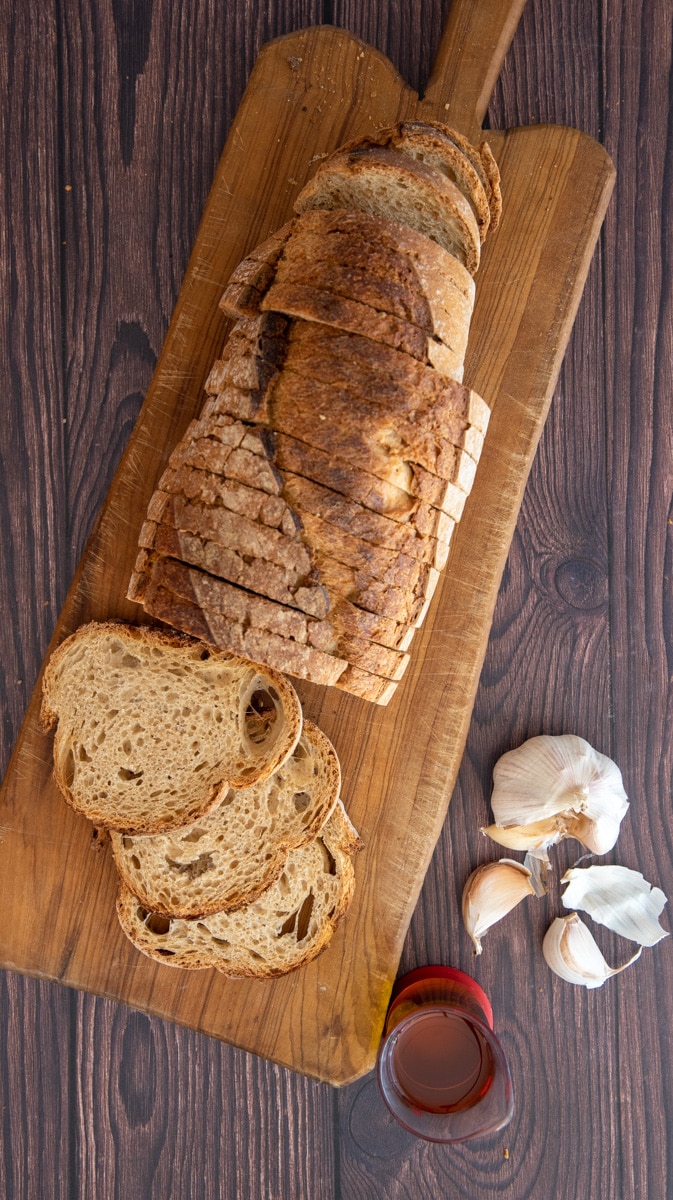
Instructions
Cutting the bread
The bread slices can be thick or thin (½ to 1 inch - 1 to 3 cm), depending on your preference and the type of topping you are using.
If you use a juicy topping, it is best to cut thicker slices. A slice that is too thin will risk breaking.
Hint: If you are toasting the bread on a charcoal barbecue, it is better to have thicker slices as the intense heat will burn the bread too quickly.
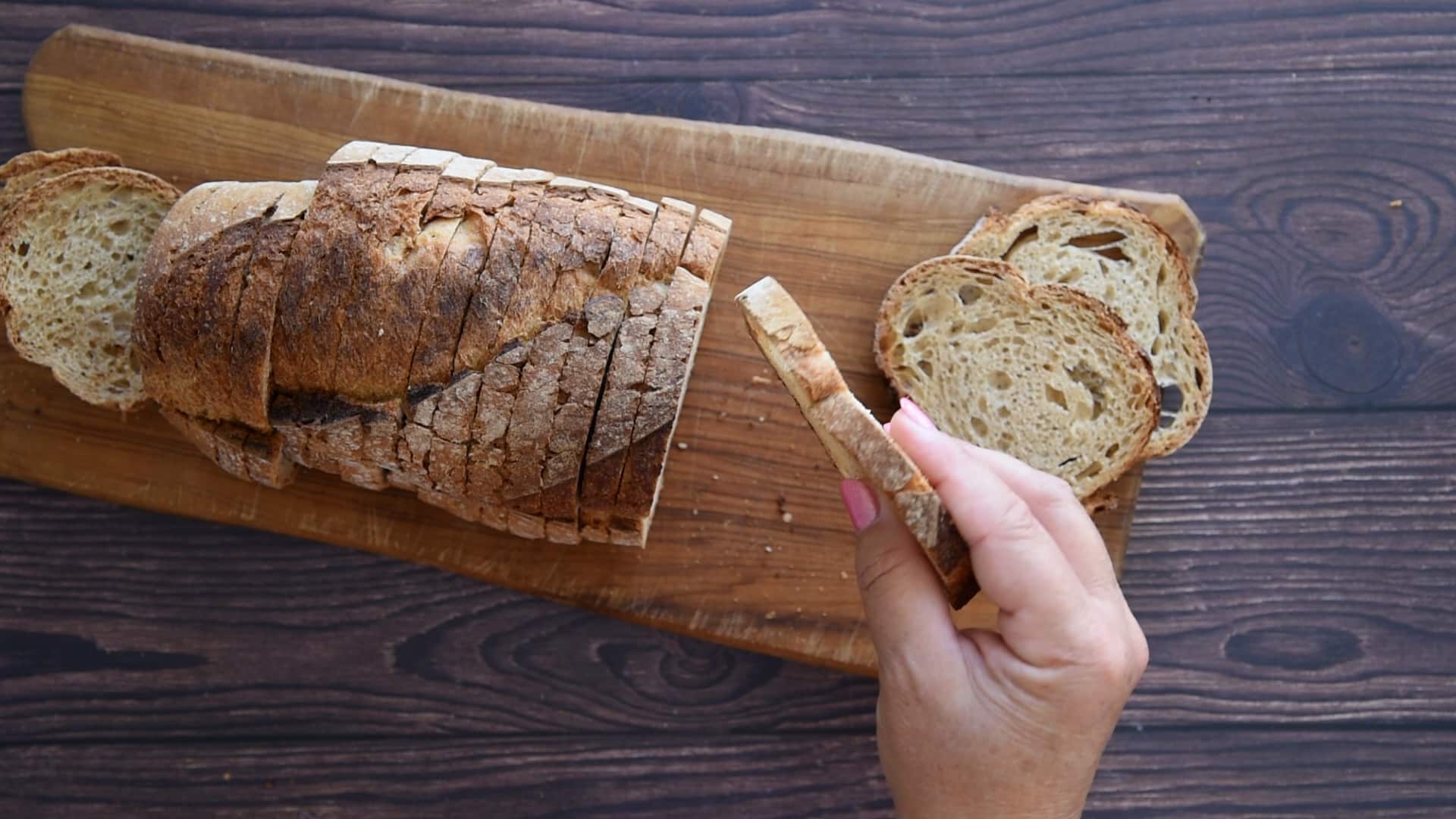
Toasting the bread on the barbecue
- Traditionally the bread is toasted over a barbecue.
- Turn the bread around to toast both sides.
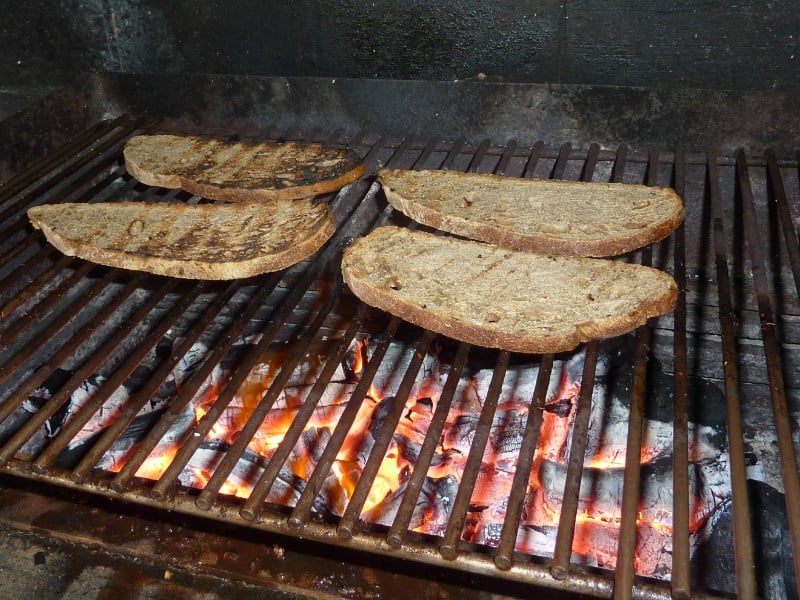
Toasting the bread in the oven
The bread can also be toasted in the oven:
- To toast the bread in the oven, it is best to use a baking tray with an open grid so the air can circulate under the bread and both sides get toasted.
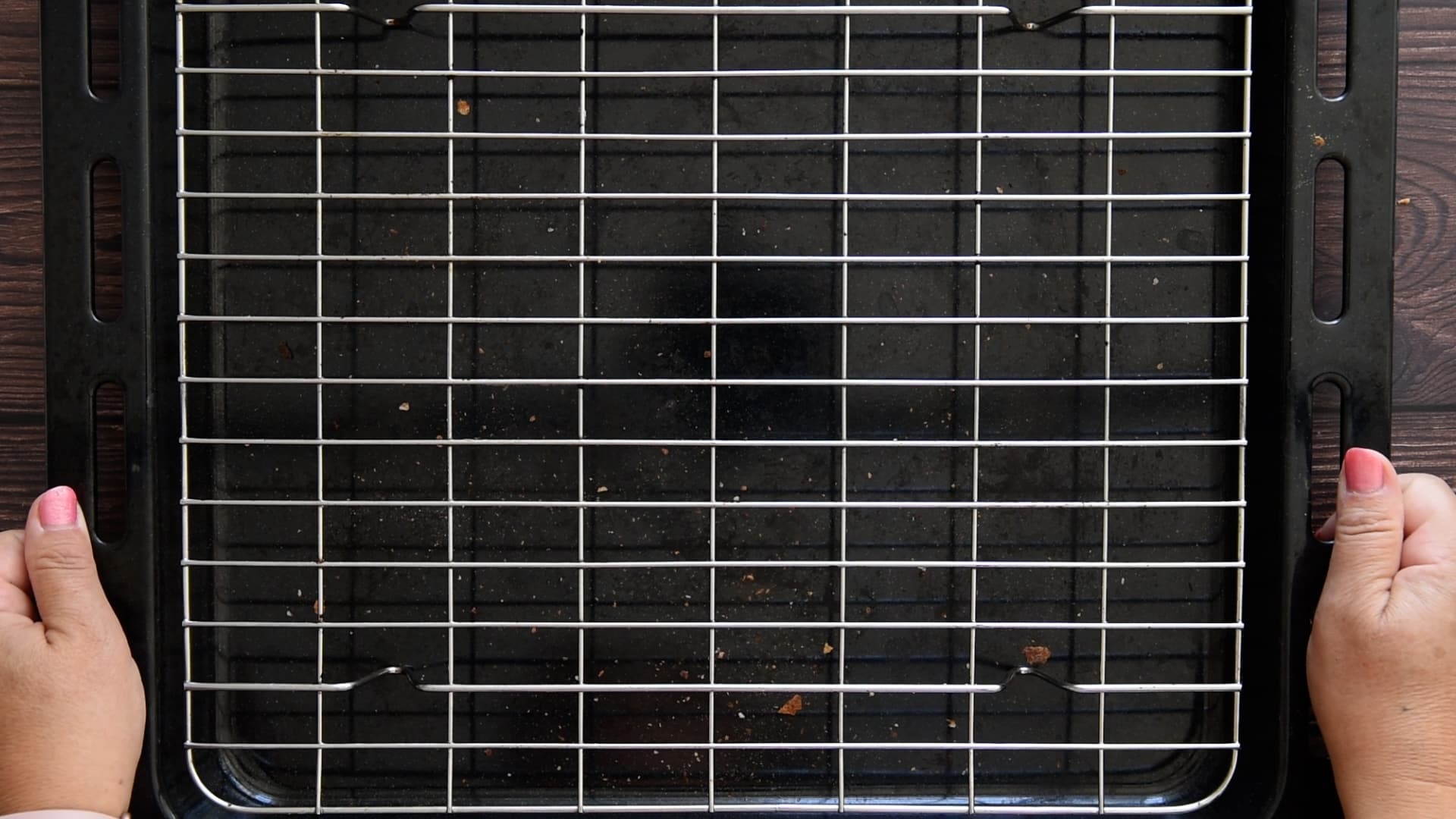
- Baking tray with a grid.
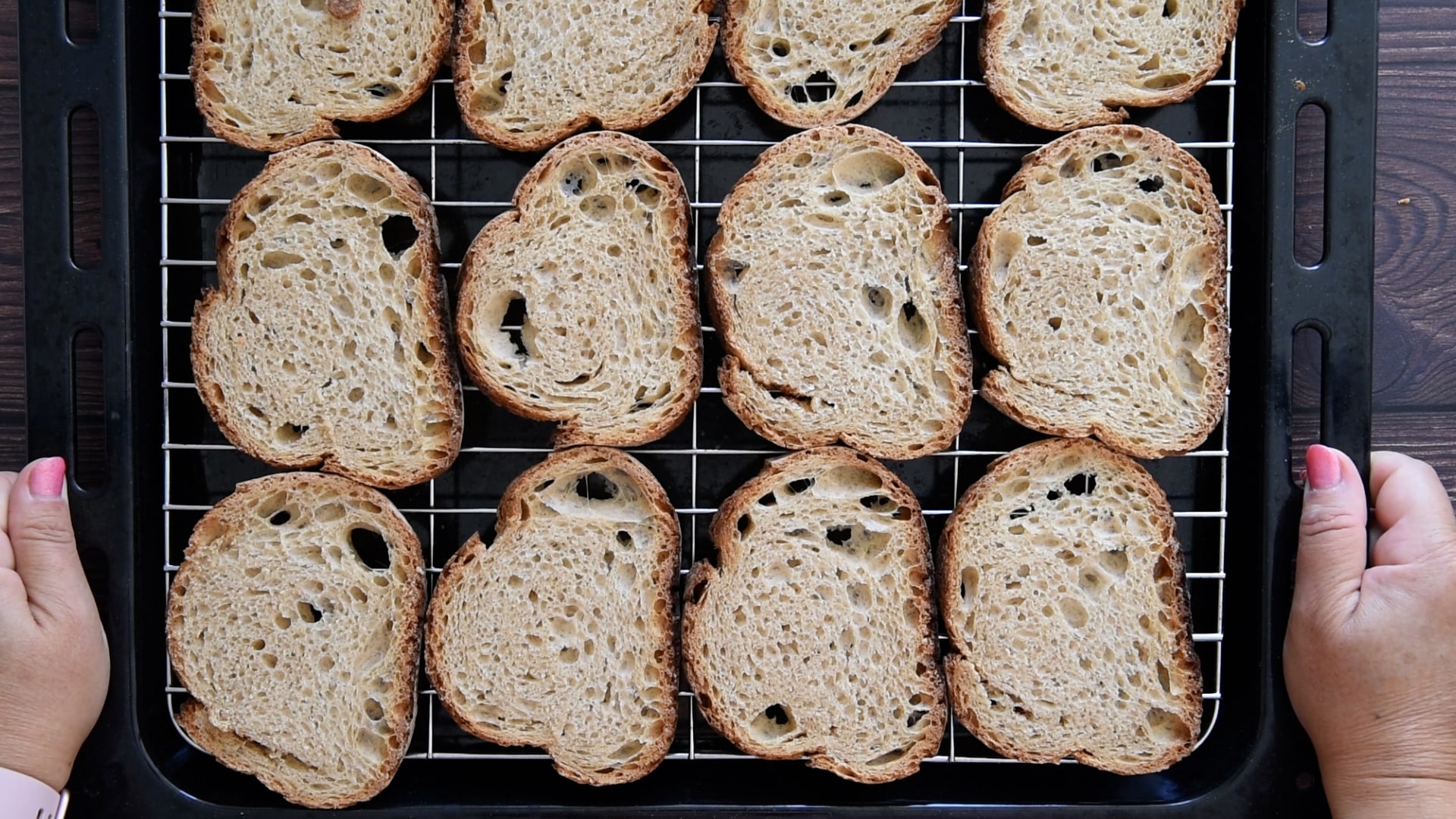
- Place the slices on the baking tray.
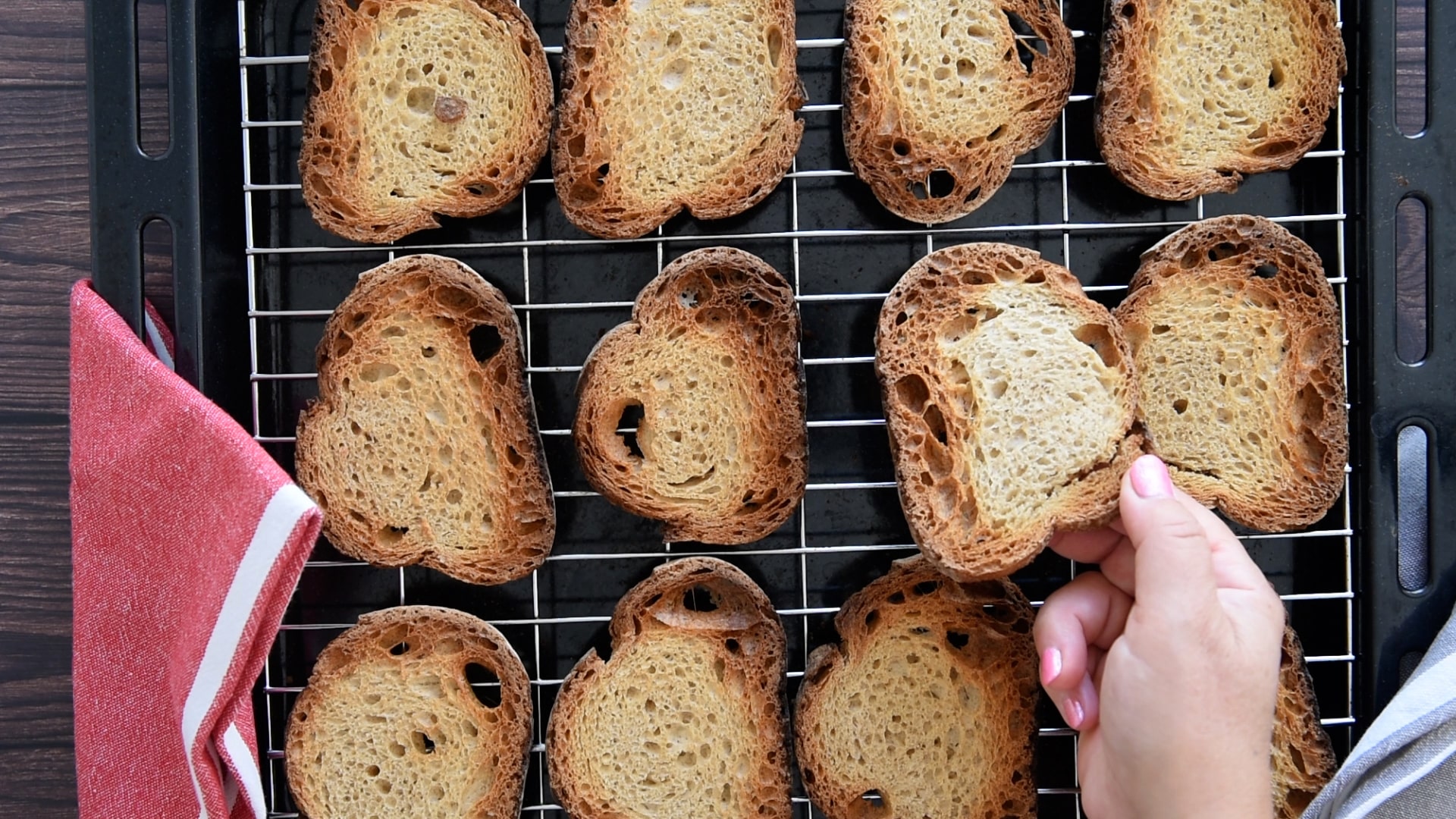
- The bread is ready once it turns brown on both sides.
Seasoning the bread
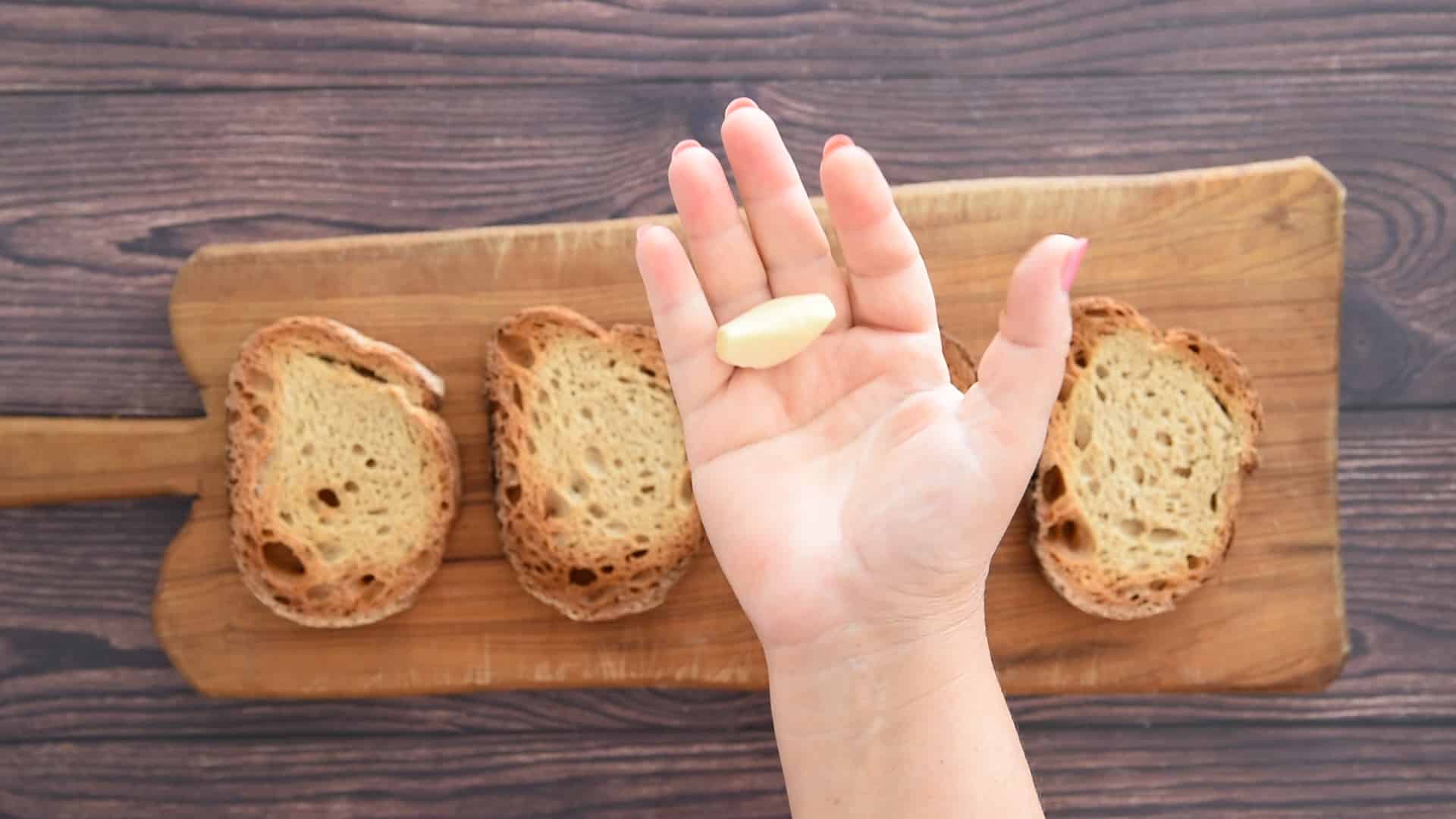
- Peel a garlic clove
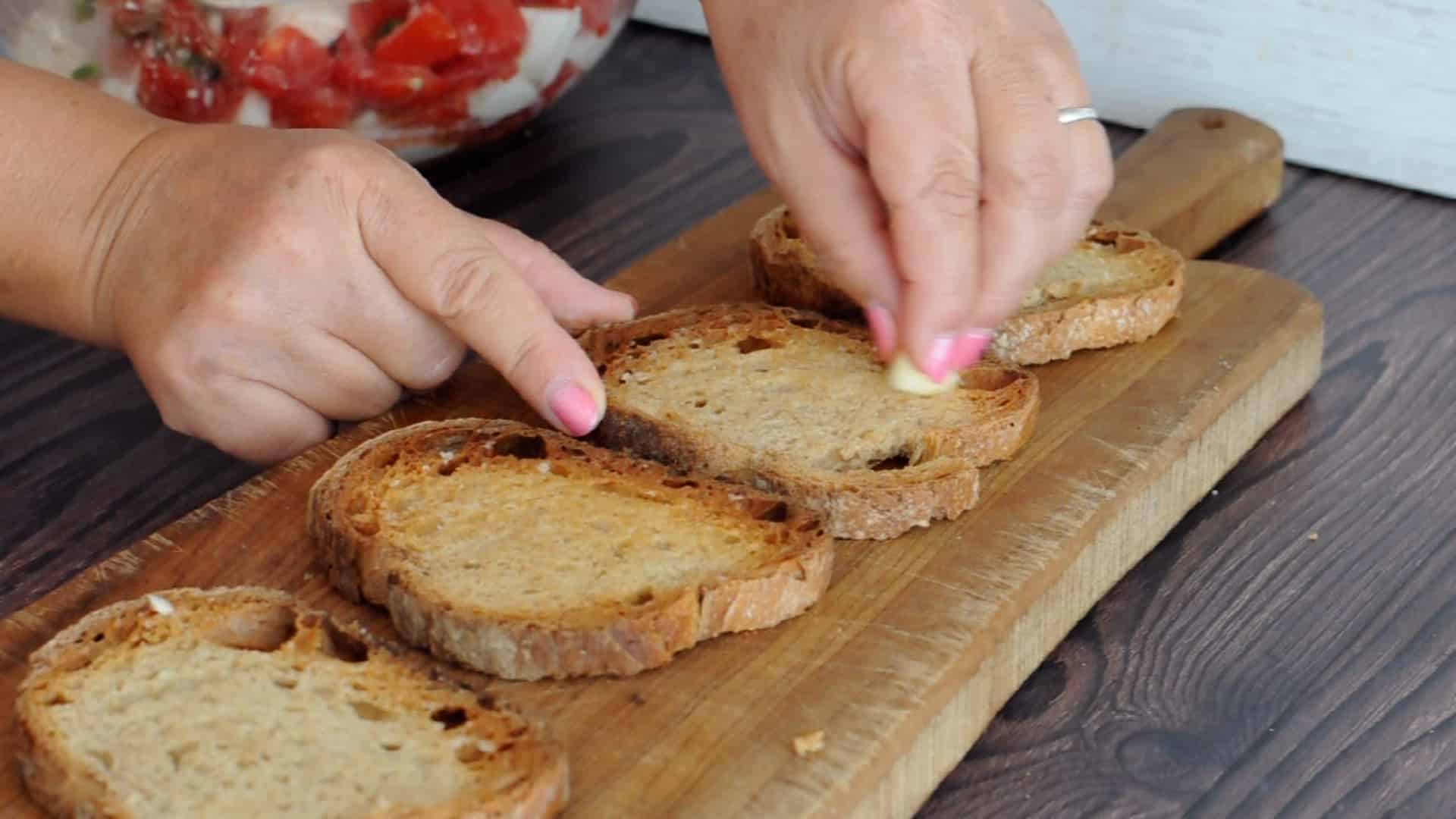
- Grate the garlic over the toasted surface of the bruschetta
Hint: The surface of the bread must be firm and crispy to grate the garlic. A baguette or soft white bread is unsuitable for a traditional Italian bruschetta.
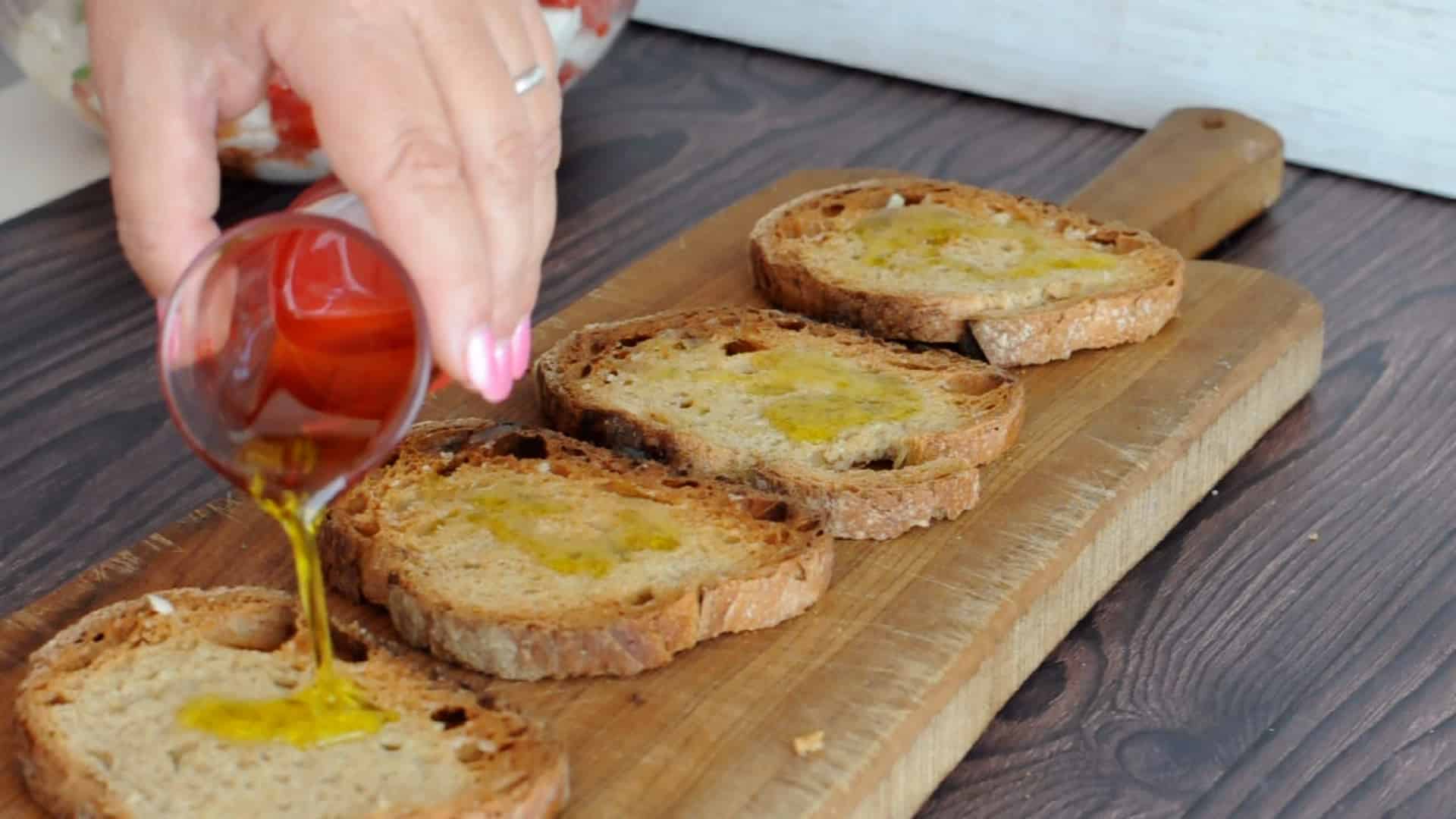
- Drizzle some extra virgin olive oil over the bread
Top tips
- The bread slices can be thick or thin (½ to 1 inch - 1 to 3 cm), depending on your preference and the type of topping you are using.
- If you use a juicy topping, it is best to cut the slice thicker. A slice that is too thin will risk breaking.
- Although they must be cut straight, the thinner side will burn before the rest is toasted.
- The surface of the bread must be firm and crispy so the garlic can be grated over.
Preparing the Caprese salad
While the bread is toasting, you can prepare the Caprese salad.
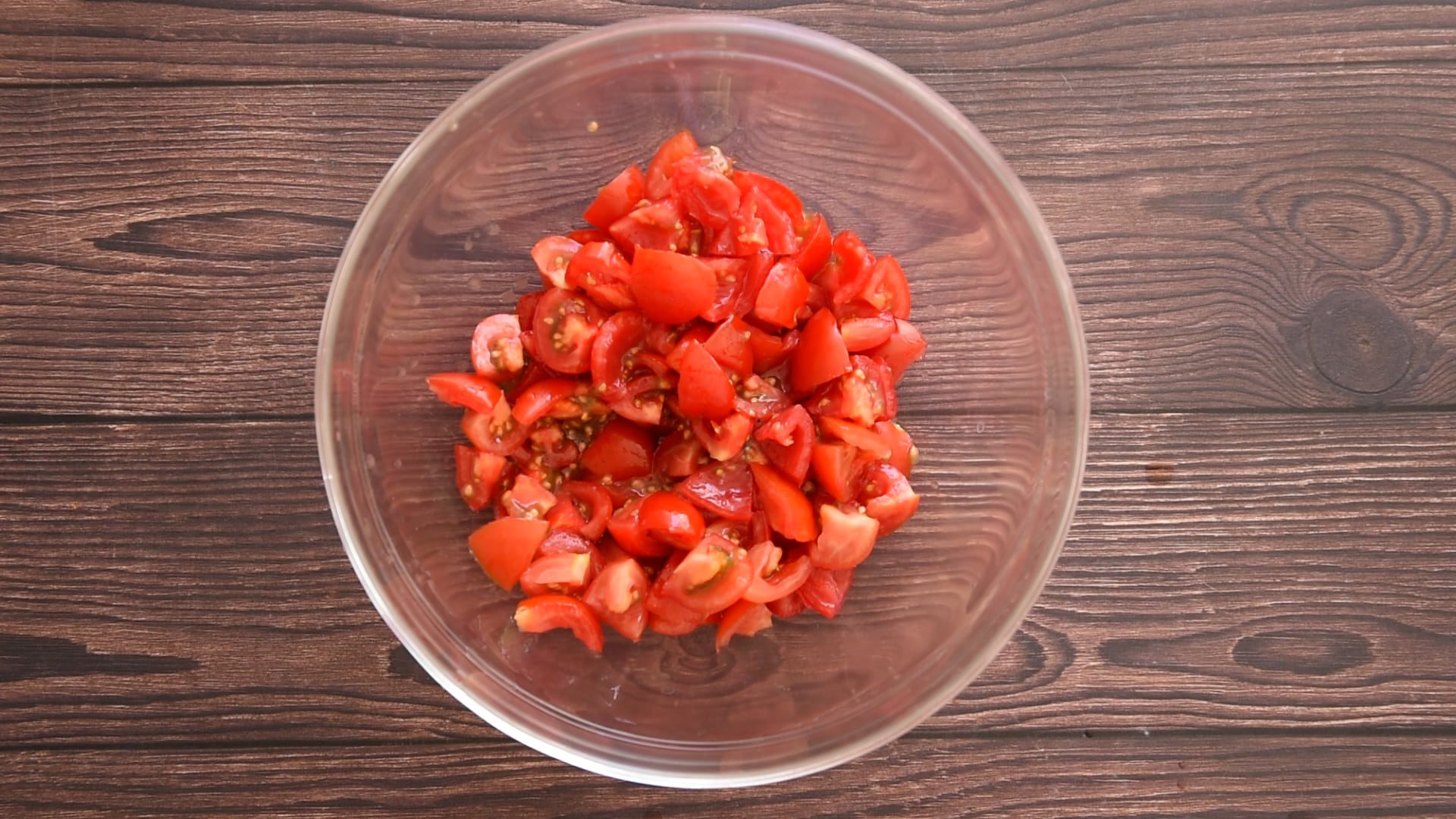
- Cut the tomatoes into small chunks. No need to remove skin or seeds.
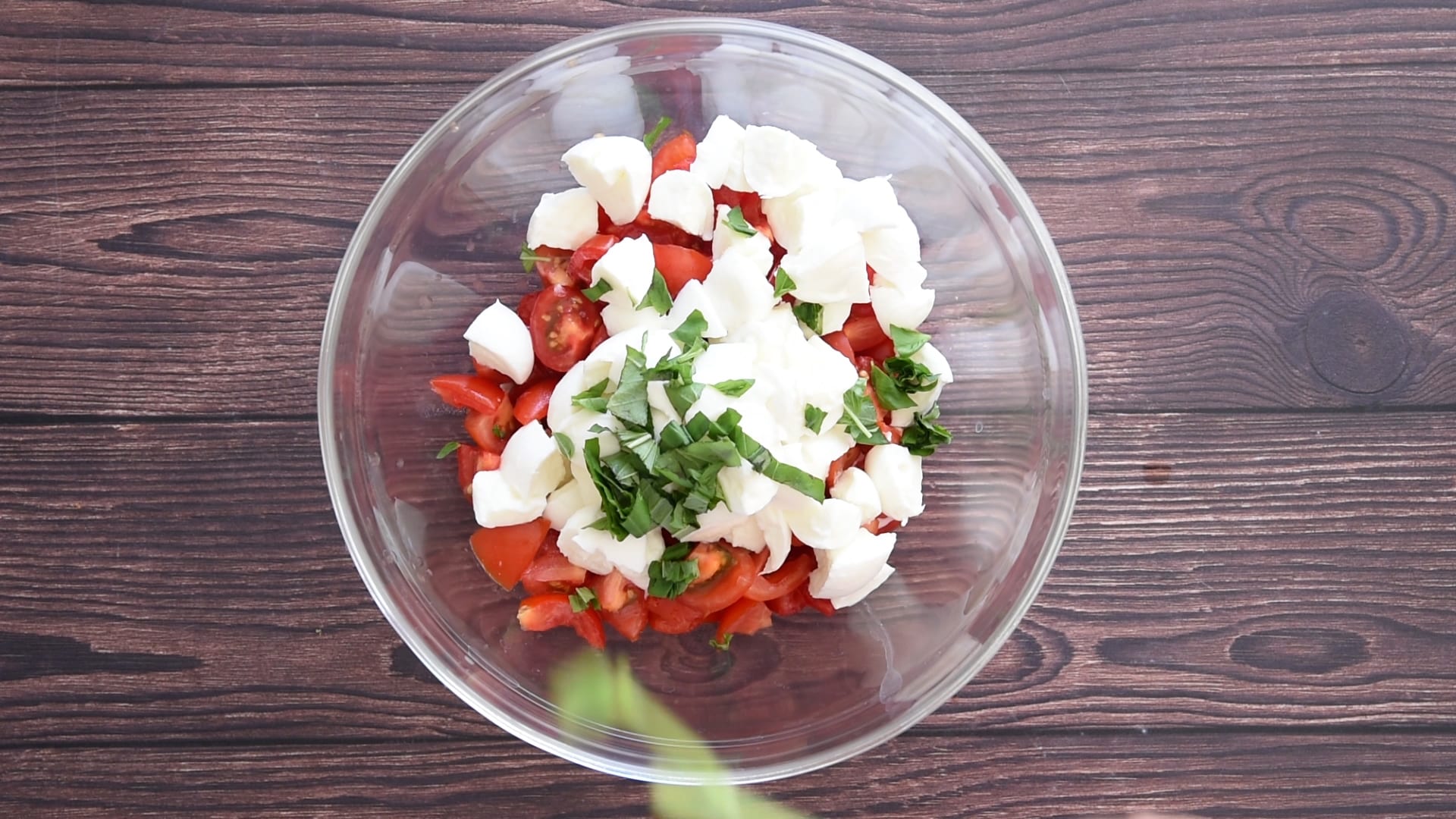
- Add some chopped basil leaves.
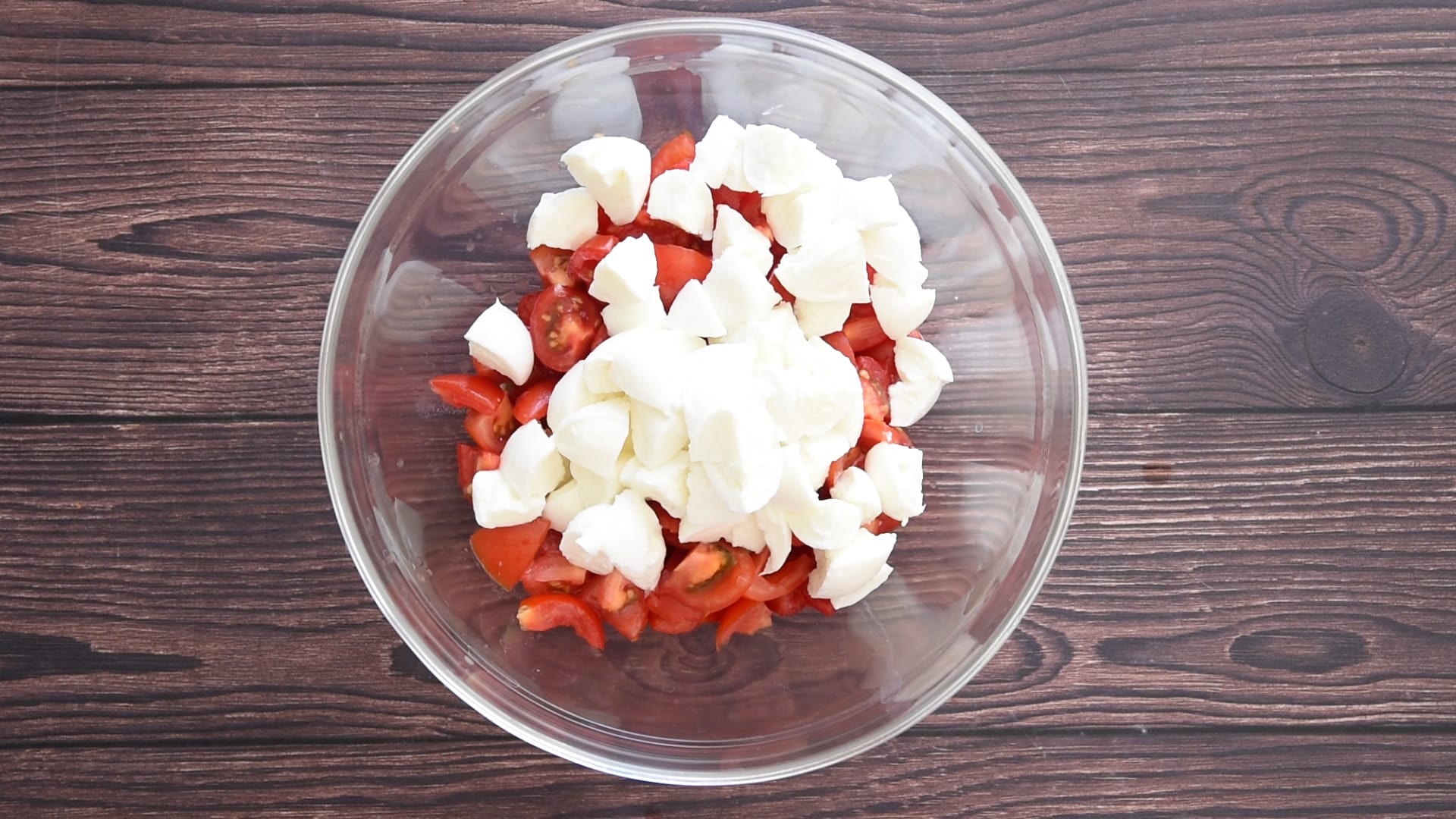
- Cut the mozzarella into the same size chunks as the tomatoes
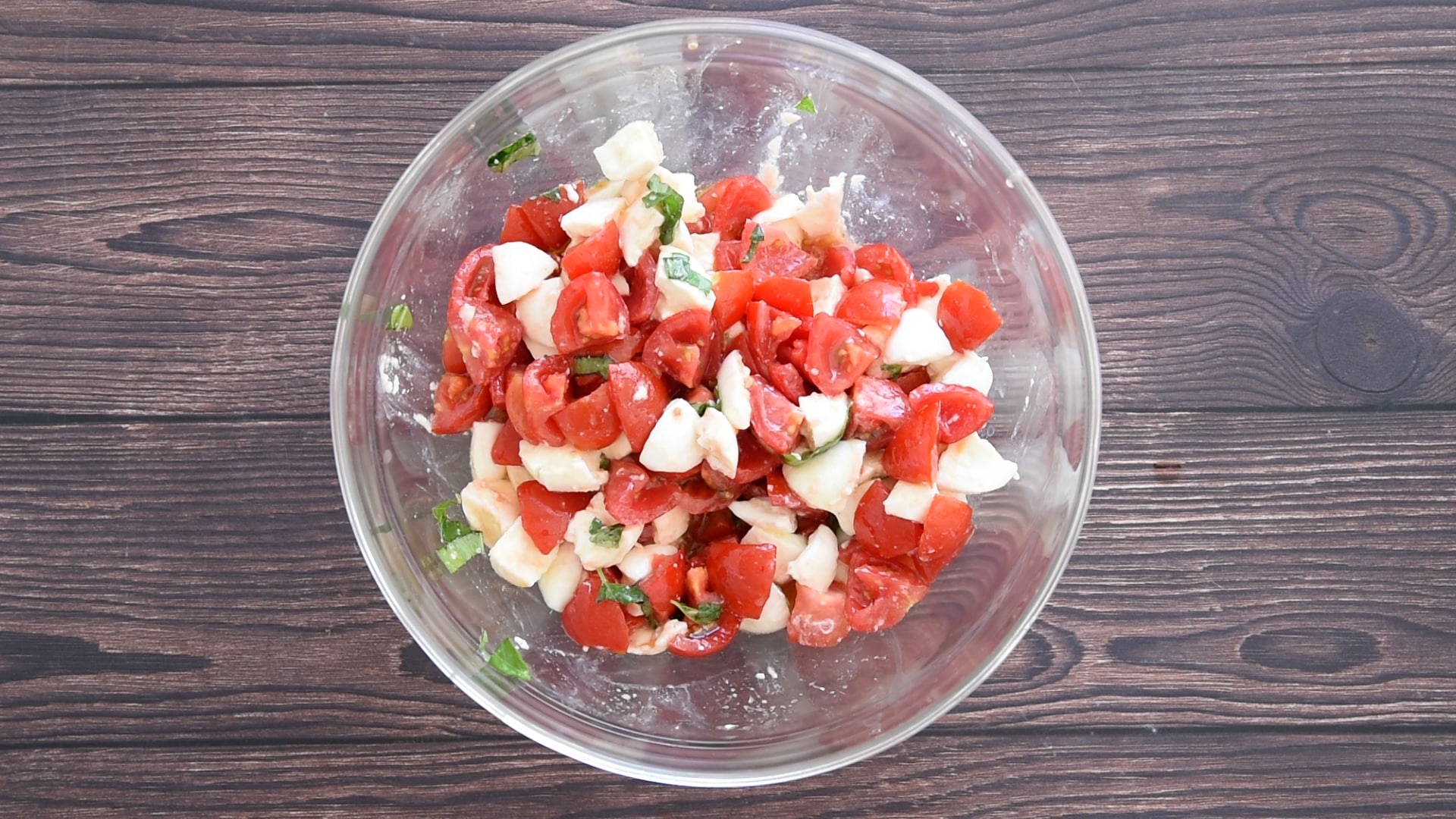
- Season with salt and extra virgin olive oil and stir
Hints: Italians never add Balsamic vinegar to a mozzarella salad
Preparing the bruschetta
Now you can place the Caprese salad over the bruschetta and serve it:
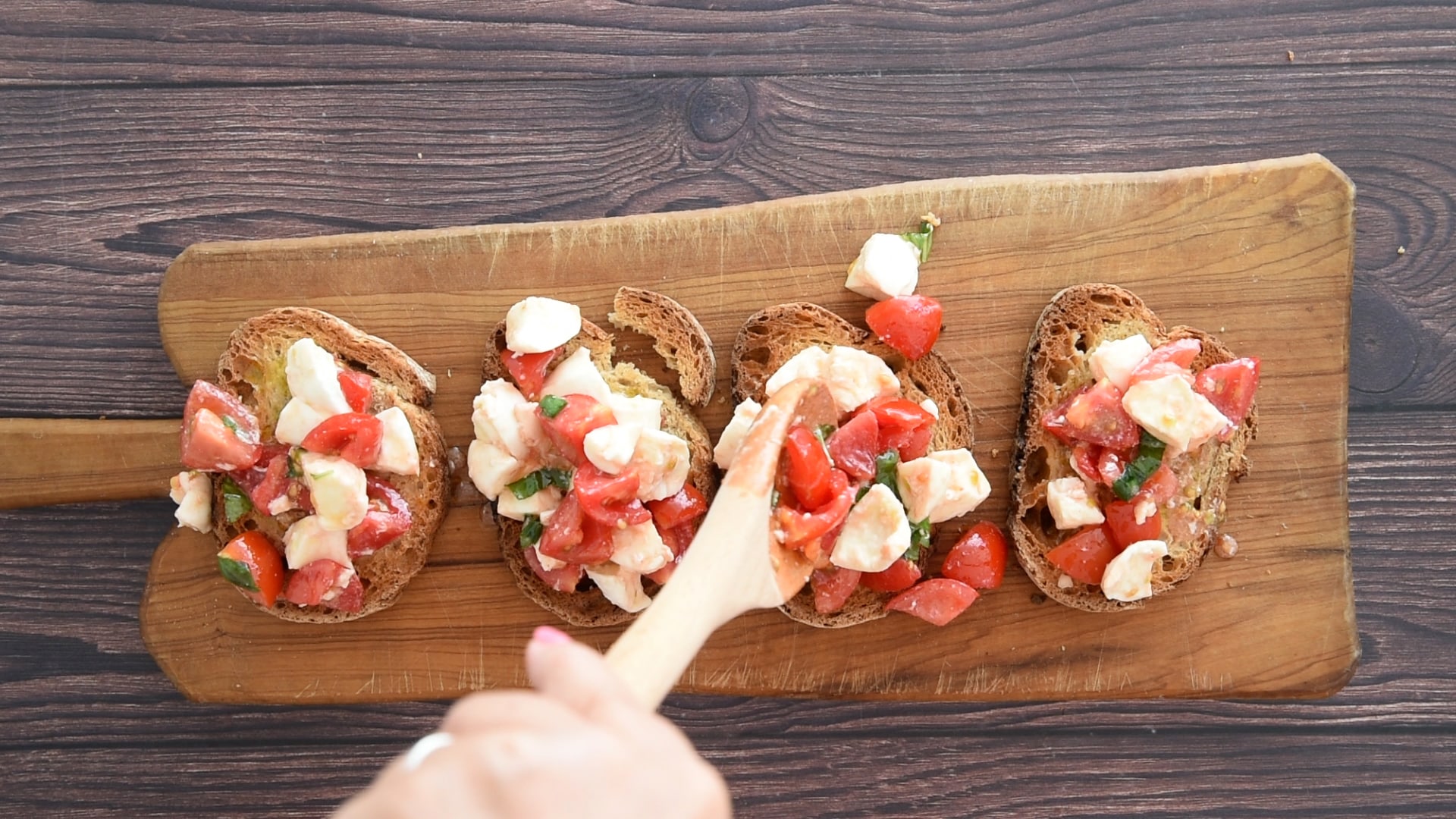
- Place the Caprese over the bread
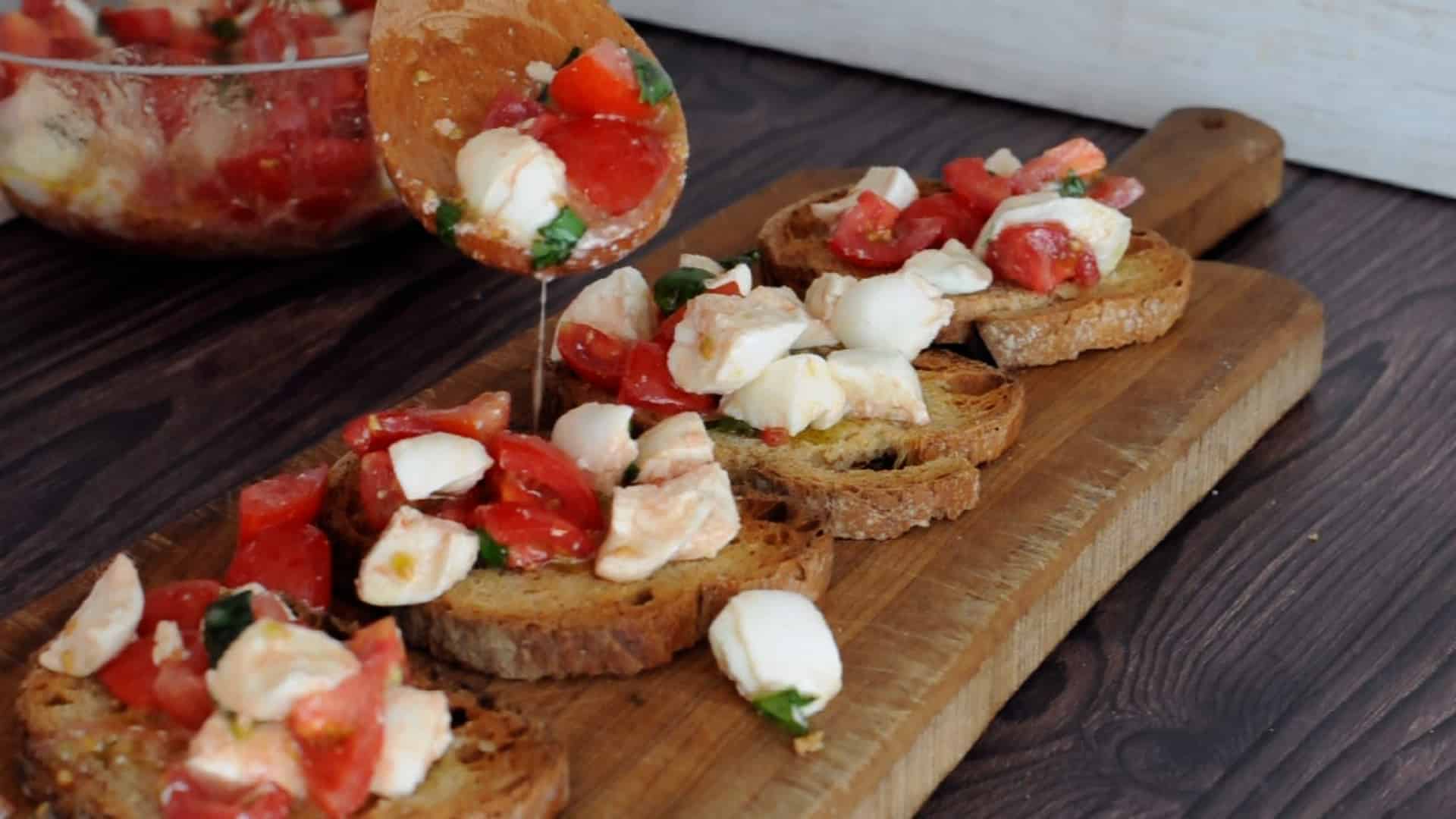
- Pour the tomato juices over the bread so it can absorb the flavors
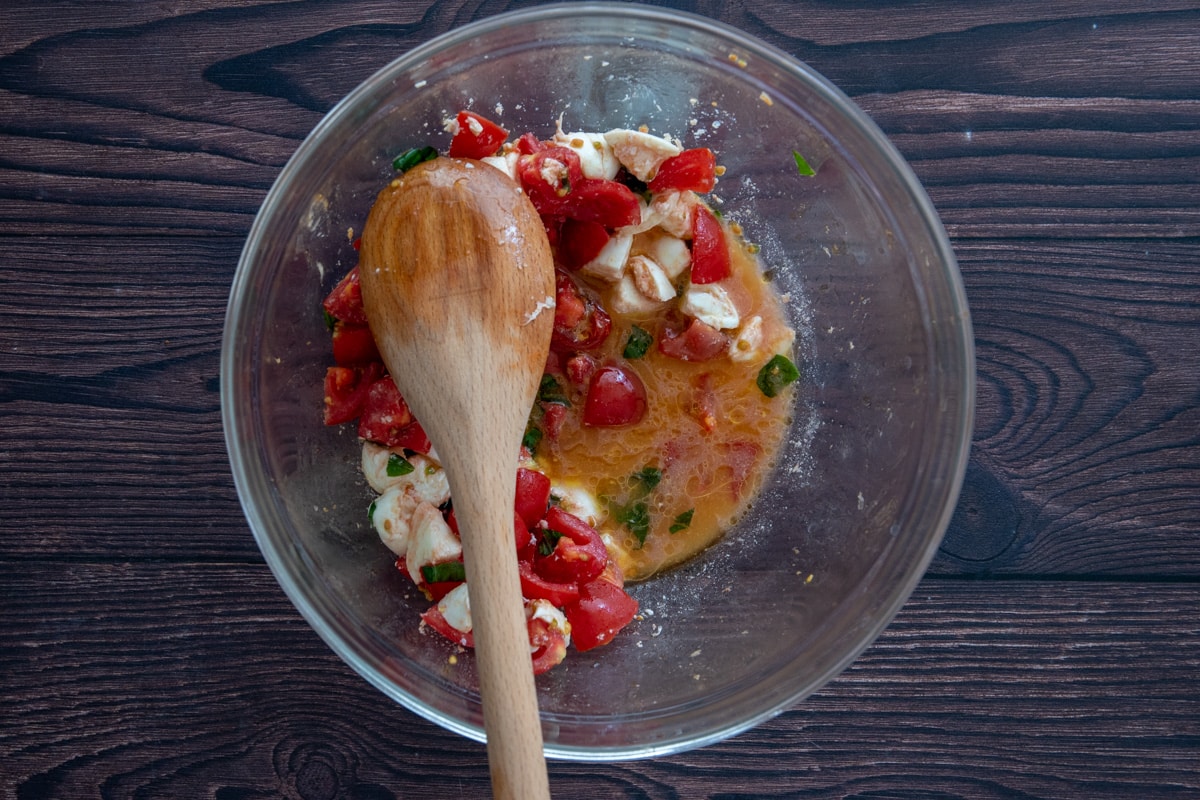
How to serve bruschetta
For Italians, Bruschetta is mandatory at every barbecue!
It is quickly prepared and served to the guests while the meat is cooking on the barbecue.
Bruschetta is served on a tray and always eaten with your hands, never with knives and forks.
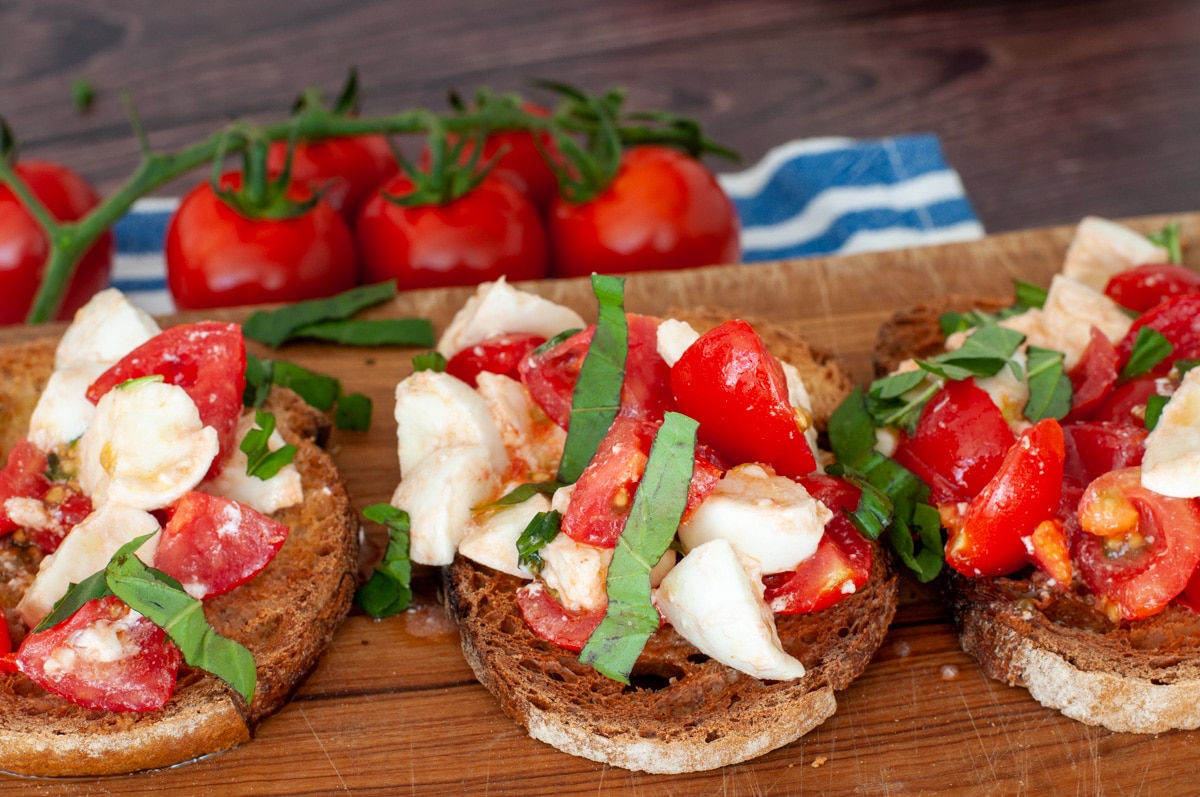
Substitutions
For a vegan bruschetta, you can omit the mozzarella and only serve it with tomato and basil.
If serving seafood as a main, you should not add mozzarella to the bruschetta.
Variations
You can top bruschetta with many different types of vegetable toppings. Here are some alternative bruschetta toppings that are also vegan, vegetarian, or regular:
- Mushrooms Bruschetta
- Caviar d ‘aubergine
- Easiest homemade hummus
- Roasted peppers
- Tomatoes pesto
- Genovese pesto
- Tapenade
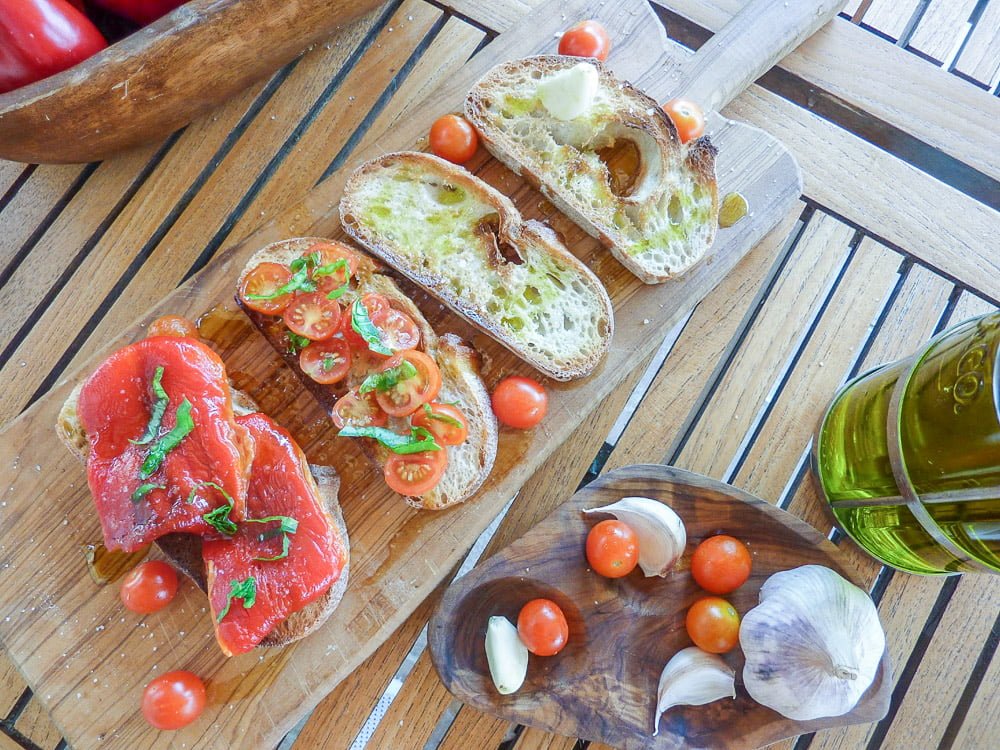
Equipment
Traditionally, Bruschetta is toasted over a grill or barbecue.
Although, you wouldn't set up a barbecue only to grill the Bruschetta. The bread will toast quickly, and you will waste all the charcoal.
You can quickly toast the bread in the oven or under the grill.
You can use a regular toaster for only a few slices.
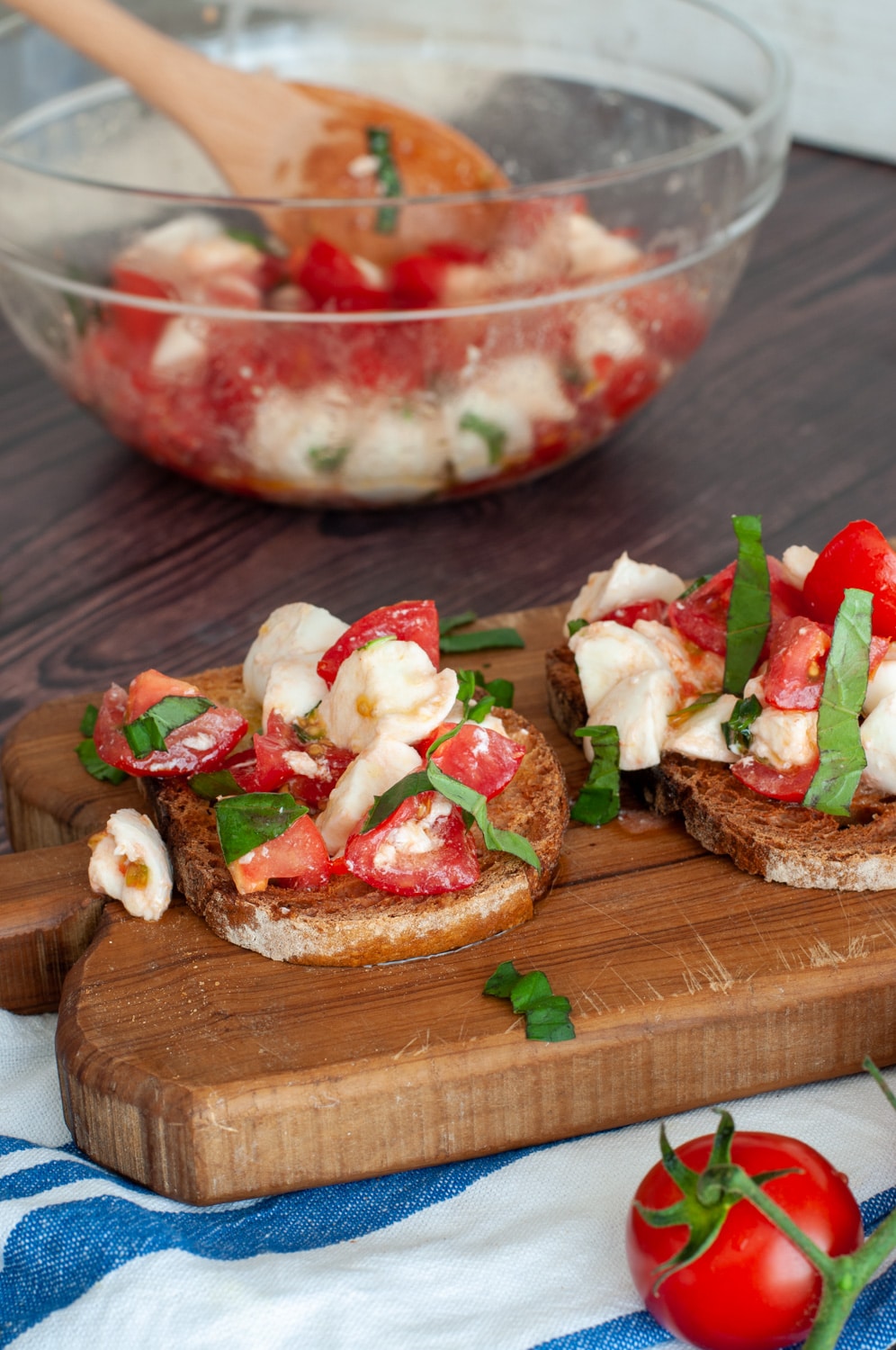
Storage
Bruschetta cannot be stored as the bread will get too soft. It should be eaten immediately.
If you toasted too much bread, do not add the topping.
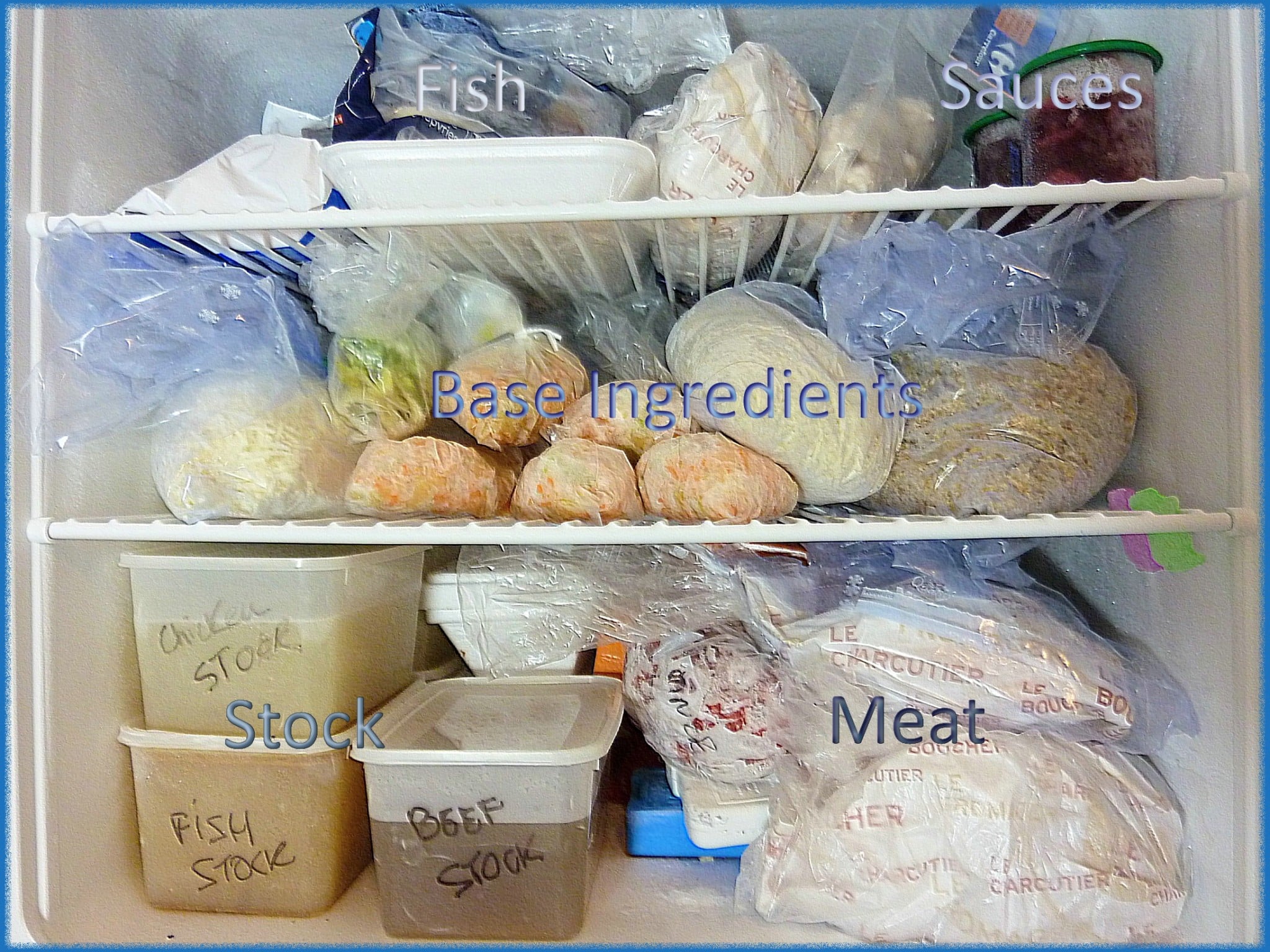
If you are making this Bruschetta recipe with mozzarella, leave your comment below I would like to hear from you. You can find more delicious ideas if you FOLLOW ME on Facebook, YouTube, or sign up to my newsletter.

📋 Italian Bruschetta Recipe With Mozzarella
Ingredients
- 1 loaf rustic bread
- 2 peeled garlic cloves
- ¼ cup extra virgin olive oil
- 1 lb fresh tomatoes
- ½ lb fresh mozzarella
- 10 Basil leaves
- 1 pinch salt
Equipment
- Electric knife optional
Instructions
Toast the bread
- Cut the bread loaf into regular slices1 loaf rustic bread
- Toast them over the charcoal or in the oven on a grid pan
Prepare the Caprese
- Cut the tomato and the mozzarella into small chunks about the same size and place them into a bowl1 lb fresh tomatoes, ½ lb fresh mozzarella
- Add the chopped basil leaves and season with salt and extra virgin olive oil¼ cup extra virgin olive oil, 10 Basil leaves, 1 pinch salt
- Stir well
Prepare the Bruschetta
- Grate the freshly peeled garlic clove over the crusty bread, and the garlic is grated by the crunchy toasted surface of the bread.2 peeled garlic cloves
- Drizzle some extra virgin olive oil¼ cup extra virgin olive oil
- Place the Caprese salad on top
- Drizzle the juices from the tomato on the bread
- Serve on a tray and eat by hand, no balsamic vinegar.
Video
Notes
- Bruschetta is made with sourdough bread; you need a hard-toasted surface to grate the garlic.
- Bruschetta is eaten by hand
- No Balsamic vinegar
Nutrition
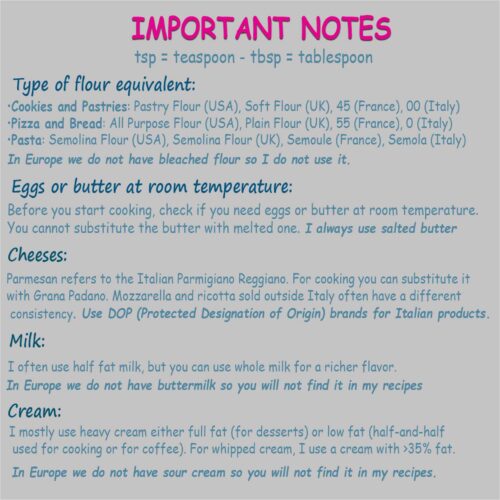
FAQ
The name EVOO is the short name for Extra Virgin Olive Oil. To be called Extra Virgin, Olive oil has specific characteristics.
First cold-pressed olive oil:
- it is the oil extracted from the first pressing of the olive
- the olive pressing should be mechanical and at temperatures not above 27 C - 80 F
- acidity level should be below 0.8% per 100 g (3.5 oz)
A simple virgin olive oil instead has an acidity limit of 2% per 100 g (3.5 oz).
The acidity is measured by instruments, while the quality of the extra virgin olive oil is based on organoleptic measurement, which is done by experts tasting.
Regular olive oil is instead extracted with chemical processes to eliminate organoleptic defects. After this process, the oil loses its color and taste and is mixed with extra virgin olive oil to give back the resemblance to olive oil. The amount of extra virgin olive oil added is just the minimum necessary.
Using a good Extra Virgin Olive Oil is very important. It can completely change the flavor of any recipe, in particular bruschetta.
I use extra virgin olive oil for all bruschetta toppings, but I never use virgin olive oil to make homemade mayonnaise; it just doesn’t work.
October is the month when olive oil is pressed, and we always wait for the new harvest to stock up for the year. After 1 year, the olive oil loses its flavor and increases acidity, so we never buy more than 10 liters. If needed, we stock it up during the year.
Olive oil should be stored in a dark container that is light-resistant. That is why it is sold in cans or greenish bottles.
The difference is simple: bruschetta is the singular name, while bruschetta is plural.
Extra virgin olive oil
Fortunately, several of my relatives produce olive oil, and every year my mother sends me 2.5 gallons - 10 liters. So I am always sure about the quality of my olive oil.
Every week I pour the virgin olive oil into small bottles, which I sometimes flavor with hot chili.
If I infuse garlic or herbs into the oil, I use it within 2 days or add some lemon to prevent the risk of botulism (toxic bacteria).
A typical Italian olive oil mix used for fish is Salmoriglio: virgin olive oil, parsley, garlic, and lemon.
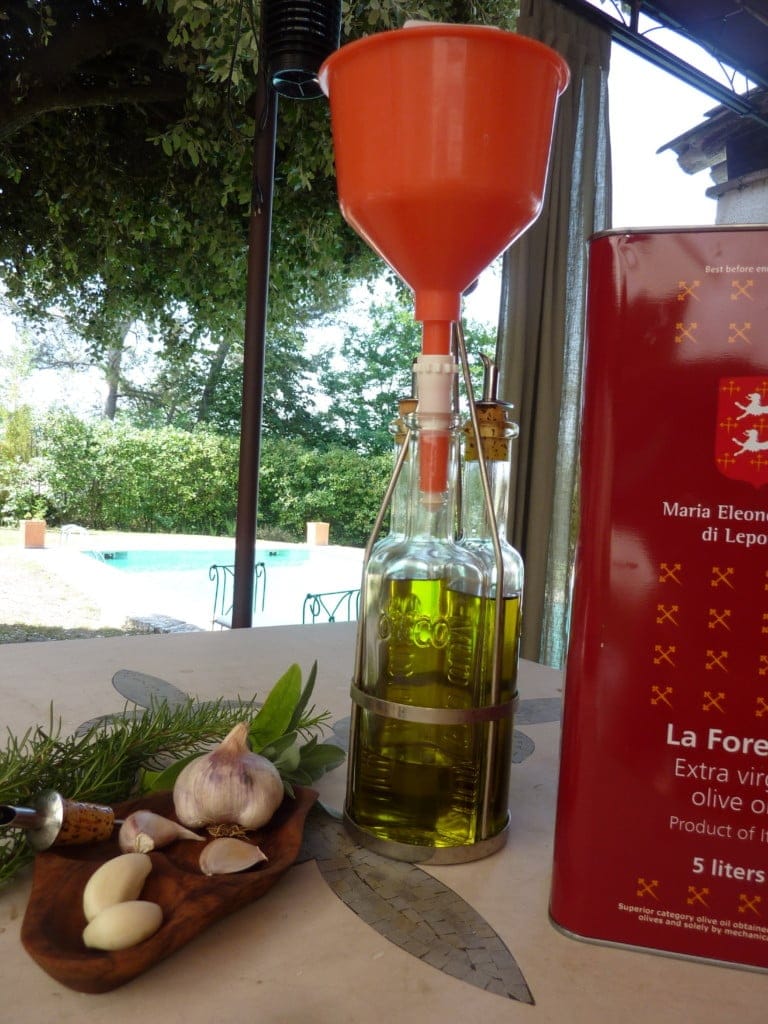
This chart created by ‘Jamie’s Italian’ beautifully describes the different types of olive oil, where it comes from, and how professionals taste it.
The chart is very comprehensive in its explanation and description.



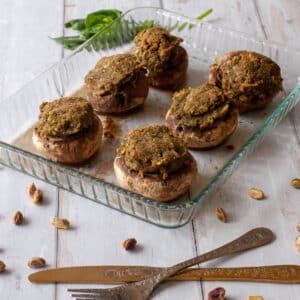


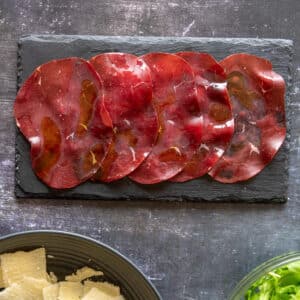
Beth
This is a great article, Laura! Here in the US, I try to buy my olive oil at specialty stores (usually Italian, of course!) We have Extra virgin olive oil here. Is that different than your virgin? Or is it just a different terminology? Thanks for the informative article!
Elaine @ Dishes Delish
I love bruschetta and I hate to admit it, but I've been pronouncing it wrong. But no more! This was a fun and informative post! Your bruschetta looks delicious and I can just imagine how it tastes!
Emma @ Supper in the Suburbs
Wow they all look fab! Bruschetta always makes me think of holidays. That buying guide is handy too! I don't know why but I presuemed most olive oil comes from Greece! Interesting to know it's actually Spain.
Laura
Thank you, I am glad you find it useful
Amanda
Fascinating post. I loved your explanations and that funnel is terrific. I think the classic tomato and basil will always be my favorite.
Laura
Thank you, I couldn't function without my funnel
Michelle | The Last Food Blog
Wow lots of really great information in this post! Great guide for buying olive oil too.
Laura
You are welcome Michelle
Patty @pattysaveurs.com
Everybody love a good bruschetta, me included! Funny how we pass along our best source of olive oil, so good! Very interesting item Laura!
Laura
Thank you Patty
Sarah Newman
Awesome! I never know the difference between different olive oils so this is helpful - thank you!
Laura
you are welcome
Kate
Great ideas for bruschette toppings. And awesome info about olive oil from Jamie's Italian. Thanks!
Laura
Thank you Kate